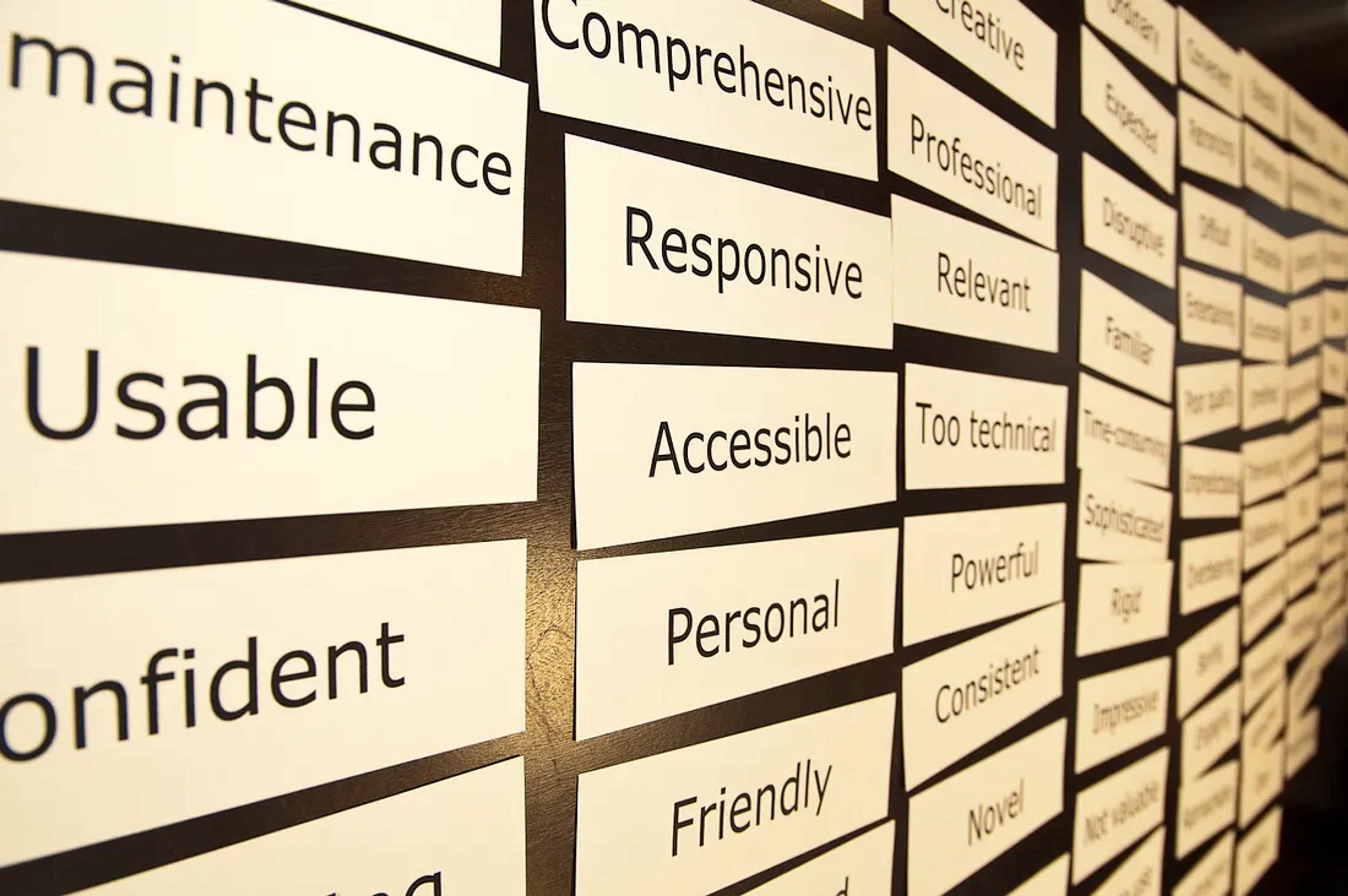Understanding customer preferences is fundamental to developing successful products in today's market. Desirability testing is a strategic method that guides brands to measure the emotions behind their products to make them resonate with consumers.
Organizations can get feedback directly from potential end-users and use the information gathered to modify their product offerings to fit the needs and desires of the customers, thus improving customer satisfaction and loyalty.
Source: Medium

What Is Desirability Testing?
Desirability testing involves assessing how emotionally appealing a product is for consumers. This approach centers more on people’s feelings towards a particular product than its functionality.
Qualitative research methods such as interviews, surveys, or focus groups may be used during this process to generate rich data. This ranges from positive emotional responses elicited by product aspects to those needing improvement.
Desirability, Feasibility, and Viability
When assessing desirability, feasibility, and viability, differentiations have to be made while recognizing their similarities. Desirability refers to how much a product or service meets the needs and wants of potential users, which they also identify. It concentrates on user experience — often determined through extensive market research, surveys, and user feedback sessions — to ensure satisfaction.
The best way to get this right is by directly engaging target audiences, who may provide insights into their preferences, helping us develop products that resonate well with them.
Source: Medium

Conversely, feasibility revolves around what is practicable when implementing an idea given available resources, technology, or even time constraints. It entails analyzing technical requirements and logistical considerations needed to actualize any concept.
This implies looking at whether current technological infrastructure can support it, besides considering the required skills plus expertise in overcoming possible challenges along its realization path. Time and budget are key determinants here since they indicate the overall chances of successful project execution.
Lastly, viability measures the long-term sustainability as well as the profitability of a project from its economic perspective. It involves such things as looking into market trends, competitive landscapes, financial projections, etc., to ensure enough revenue generation within it over time, which will also bring back returns on investment made into it.
Examining different income models alongside potential growth areas could give us a better understanding of whether this initiative can work out or not.
Even though these three ideas are different, they share one common purpose: determining success for any new undertaking. They should complement each other because something desirable has been proposed.
Source: Medium

The Psychology Behind Desirability
To create well-performing and emotion-triggering products, one must understand why people desire certain things over others. Emotional ties often emerge from personal experiences, cultural beliefs, or individual principles.
Customers who believe that a product aligns with them as individuals or what they aspire to in life have higher chances of preference and purchase. These feelings build from how marketers narrate stories, which make people nostalgic, give them a sense of belonging, or make them happy.
Desirability is also primarily influenced by aesthetics, design elements, and user experience. A product's physical appearance, such as its color, shape, and texture, can evoke positive emotions, thereby increasing customer appeal. Furthermore, if the user experience is frictionless—meaning that interacting with the product feels natural and pleasurable—it further enhances this emotional bond.
Both these elements create initial interest in brand attributes and influence long-term brand loyalty because satisfied consumers tend to promote products that resonate emotionally.
In essence, the psychology behind brand attributes and desirability allows businesses to make offerings that address the deep-seated emotional needs of their audience, consequently leading to market success.
Key Methods for Desirability Testing
A/B Testing
To find out what customers want and how they feel about it, we can employ various methods of desirability testing. These help businesses better understand their clients by identifying what catches their attention.
A common technique is A/B testing, where different versions of design elements or features are compared to see which one gets a more positive emotional response from users.
In this process, people are split into groups that show different variations of a product or feature. Such controlled comparison enables the detection of slight changes in consumer behavior.
Source: Cloudcone

Card Sorting Exercises
Card sorting exercises are another excellent technique for asking participants to organize concepts or product features into meaningful categories. Participants are usually given several cards with different ideas or features represented on each one. Then, they must group them according to what they comprehend and the best method.
This can show companies which parts of design variations their offering matter most but might not otherwise be apparent by uncovering patterns and priorities among consumer perceptions towards various aspects of a product. It also helps businesses know better where design should be focused, ensuring that whatever is finally produced meets user expectations.
Semantic Differential Scales
Semantic differential scales are also valuable in gauging desirability and consumer choice. In this method, individuals are requested to assess products using a range of opposite adjectives (e.g., attractive-unattractive, appealing-unappealing).
Respondents rate their position on a continuum between the opposing pairs of negative adjectives on a word list of adjectives presented to them, typically consisting of a few points.
These measures help measure emotional reactions and provide more insight into what people feel about a product. They often show slight perceptual differences intended for emotional response that other methods may fail to detect.
By studying these ratings, researchers can identify latent consumer attitudes, which, depending on how they are interpreted, can help develop new products or marketing strategies.
Interviews and Focus Groups
Furthermore, interviews and focus groups allow for more in-depth conversations with potential users, leading to participant responses and richer qualitative insights.
Such discussions explore deeper emotions, motivations, and perceptions around the item, thus enabling brands to gather detailed feedback and better understand their audience's emotional needs.
With these techniques, businesses can measure and improve their products' visual appeal, increasing customer involvement and satisfaction.
Source: Voxco

Conducting Effective Desirability Tests
Planning and Preparation
A highly structured approach is vital for the desirability tests to be practical. Planning and preparation are the initial phases. This means setting clear goals for the test, such as finding out user preferences or measuring how attractive a given product is.
It also involves identifying the main questions to be answered, such as which features users find most appealing or what could be improved. Equally important is selecting methods. These may include questionnaires, interviews, and focus groups, among others.
Therefore, a test plan should cover everything, including timelines showing when each stage of user testing will occur, required resources like staff and money, and tools needed for implementation, ranging from data analysis software to survey platforms. Such careful planning guarantees actionable insights from desirability testing that can shape product development and marketing strategies.
Selecting Participants
Collecting the right insights is critical. Thus, you must select your participants carefully. Make sure that all those participating represent different types of users who form part of your target audience while choosing them.
Apart from age, sex, and location of target users, one should also consider other things like ways of life, income levels, or even technological know-how. This will enable the brand to get feedback from participants from many different designs of people with different views.
Companies should involve individuals from various backgrounds with diverse preferences and experiences since it helps capture a broader range of opinions about what is happening in the market generally.
Such an inclusive panel enables a company to identify areas where they can improve their products through innovation so that such goods may satisfy clients’ needs much better than before. Moreover, involving various players may bring about unforeseen findings or accentuate particular outlooks that would be ignored.
Source: Akwatoria

Test Scenarios
To advance a reliable product, it is necessary to form test scenarios mirroring real-life situations. The idea behind these cases is to make users feel like they are interacting with the system.
In other words, this implies that such conditions must be designed to elicit genuine emotional responses and encourage honest feedback.
So, observing what happens when individuals participate in this exercise can be valuable by looking at their body language and faces and noting any challenges faced during interaction with the product.
Reactions given or comments made by participants while testing provide essential clues about user experience, which could be used for polishing and enhancing the product even more.
Collecting and Analyzing Data
Finally, collecting and analyzing data helps draw meaningful insights from tests undertaken thus far. Qualitative and quantitative data-gathering approaches must be employed to fully understand consumer preferences regarding designs, features, etc.
There are many ways to interpret findings, with design options ranging from simple coding systems to conceptual options based on observed facts/themes to statistical analysis where necessary.
Through this process, we not only identify factors contributing to the desirability of design elements but also provide input on conceptual design options for future design choices, which would result in more resonance with end-users in terms of product.
Integrating Desirability Testing into Product Development
Including desirability testing in product development is crucial to creating successful products. Knowing when and how often desirability tests should be conducted during the product life cycle is essential.
They should generally happen at early stages, like concept validation, design iterations, and pre-launch phases. For example, carrying out examinations at an early stage may help form product features that match user expectations from the beginning on an aesthetic level.
Source: blog.insidethehood

In addition, working with design teams alongside marketing teams can make desirability tests more robust. These groups can create one united plan together, which involves customer insights for use in designing products and promoting them through advertisements, etcetera, where user interface and emotional narratives must be consistent across all platforms. This collaborative approach will enhance the overall desireableness of the goods being sold.
Furthermore, brands should adopt an iterative testing and refining design process. With continuous desirability testing, businesses can keep pace with changing consumer needs while remaining relevant, given that preferences shift over time.
These assessments enable enterprises to stay responsive toward market dynamics. Thus, by consistently incorporating feedback into every stage of the product’s creation, companies will solve people’s problems and create strong emotional ties that foster loyalty, leading to further success within respective markets.
Common Challenges and How to Overcome Them
Several challenges will likely occur during desirability studies and tests, which may limit the process's efficiency. One fundamental problem with desirability study and other methods is biased testing, which can distort findings and misrepresent consumer preferences.
To prevent this, research participants need to ensure that participants are chosen from various backgrounds and that, where necessary, blind methods are adopted to reduce extraneous factors.
Source: Medium

Another challenge is striking a balance between the desirability factor and usability. While it is crucial for any given item to be attractive, it must also meet users' practical needs.
To solve this puzzle, brand teams need to give more weight to what customers say about the aesthetic appeal and functionality of user interface when testing such products, thus ensuring they satisfy all ends.
Resource limitations like time or money are also among the difficulties experienced when conducting comprehensive desirability tests. Companies should consider using cheaper tests, such as remote usability testing or digital tools that allow many people to participate readily.
By overcoming these problems through careful planning backed up by flexible approaches, businesses can improve their ability to test for attractiveness and enhance their product offerings.
The Future of Desirability Testing
The landscape of desirability testing is on the verge of significant change as technology develops. Thanks to emerging technologies like eye-tracking and emotion recognition, brands can assess consumer preferences in a new way.
Eye-tracking technology can show what parts of a product users look at most, which means it can also reveal the features that draw or repel attention. Such data can be used to make further design decisions and changes to increase desirability and improve user experience.
Furthermore, advanced emotion recognition software allows us to analyze facial expressions and bodily reactions while people interact with products so that we can understand what they’re feeling. This allows businesses to collect emotional feedback in real-time, thus enabling them to conduct more sophisticated desirability evaluations.
Source: Giu Vicente on Unsplash

Another thing brands should keep in mind is that consumer behavior shows an increasing demand for individualized experiences. When companies use data analytics and AI technologies, they can adjust their approaches toward testing appeal according to individual preferences, thereby creating offers that resonate personally.
Combining this technological advancement with understanding how people think about their wants could drive engagement levels through desirable testing, satisfying functional and emotional desires.
Read more:
Conclusion
To sum up, product designers must assess and improve their products' attractiveness to effectively engage customers and foster their satisfaction. Through various methods, including card sorting exercises, semantic differential scales, quantitative and qualitative methods, interviews, etc., brands gain insight into consumer preferences and emotions, which is helpful for future reference when developing similar goods or services.
As time passes, we shall integrate these eye-tracking features with other mechanisms that recognize emotions in our systems. Hence, it enhances user experience (UX) knowledge and elicits an emotional response(s) from them.
Businesses can create more than functionally sound items by focusing on the desirability factor during the user research and design stages. They can also touch the hearts of buyers even more profoundly, thus ensuring loyalty throughout a competitive market.


About Clay
Clay is a UI/UX design & branding agency in San Francisco. We team up with startups and leading brands to create transformative digital experience. Clients: Facebook, Slack, Google, Amazon, Credit Karma, Zenefits, etc.
Learn more

About Clay
Clay is a UI/UX design & branding agency in San Francisco. We team up with startups and leading brands to create transformative digital experience. Clients: Facebook, Slack, Google, Amazon, Credit Karma, Zenefits, etc.
Learn more


